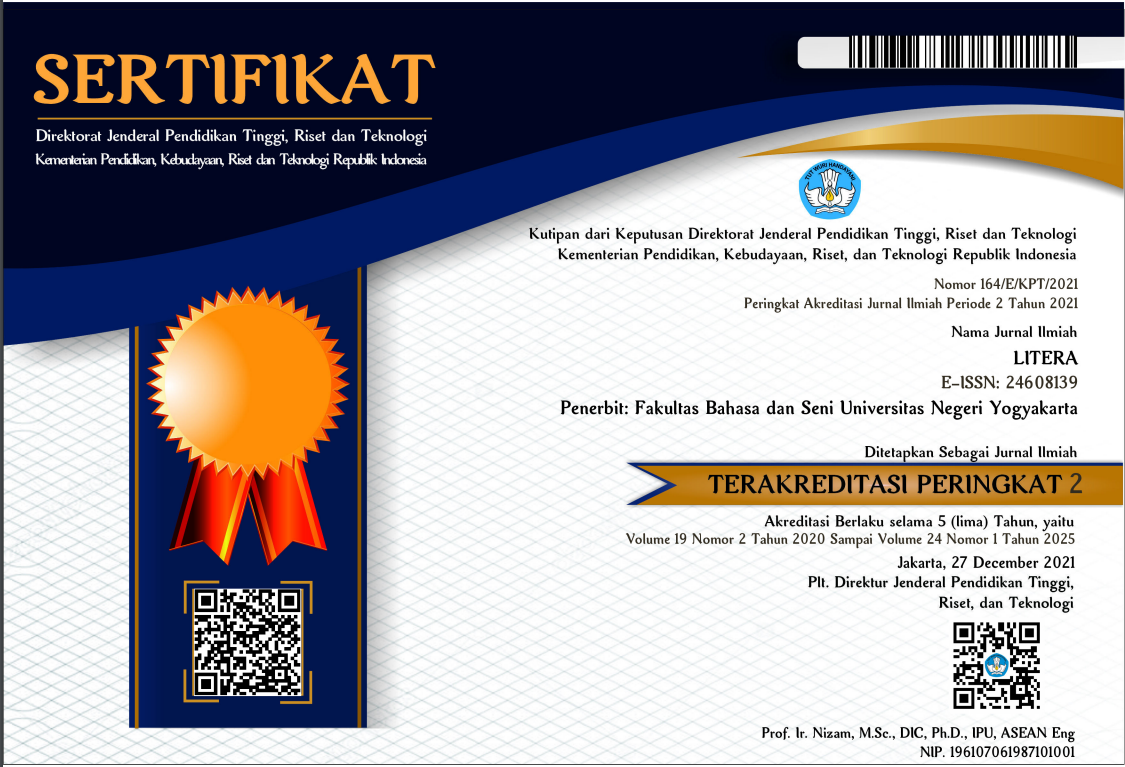THE STRUCTURE AND FORMULA OF GERONG LYRICS IN THE PRAMBANANRAMAYANA BALLET
Ida Rochanib Adi, UGM
Heddy Shri Ahimsa, UGM
Abstract
Gerong lyrics as the only orality in the Prambanan Ramayana ballet no longer present
the story of Rama in its entirety. Although most gerong lyrics contain the scenes, the singers
are not always fixated on the lyrics, but prioritize the tones of the chants. This study aims
to reveal the structure and formula of gerong chants in the Prambanan Ramayana ballet. It
used Levi-Strauss’ structuralism theory and Albert Lord’s formula theory and employed
the qualitative descriptive method. The data were gerong lyrics and their chanting and
various supporting orality elements. The results of the study show that the structure in
the form of geronginter-lyric relation does not show the Ramayana story plot. In addition,
a gerong chant formula is found. The chant formula becomes one of the developments of
Lord’s formula theory giving priority to the formula of the oral lyrics.
Keywords: Ramayana Ballet, structuralism, formula, gerong, chants
Full Text:
PDFReferences
Ade j unmobi , Mor ade wun. 2011.
“Revenge of the Spoken Word?:
Writing, Performance, and New
Media in Urban West Africa” dalam
Oral Tradition, 26/1 (2011): 3-26. Slavica
Publishers, Inc., Indiana University
Ahimsa-Putra, H. S. 2001. Strukturalisme
Lévi-Strauss, Mitos dan Karya Sastra.
Yogyakarta: Galang Press
Gidden, Anthony. 2009. Problematika
Utama dalam Teori Sosial, Aksi, Struktur,
dan Kontradiksi dalam Analisis Sosial.
Yogyakarta: Pustaka Pelajar
Hastanto, Sri. 2009. Konsep Pathêt dalam
Karawitan Jawa. Surakarta: ISI Press
Koentjaraningrat. 1994. Kebudayaan
Jawa. Cetakan kedua. Djakarta: Balai
Pustaka
Koerbin, Paul. 2011. “Pir Sultan Abdal:
Encounters with Persona in ALévi
Lyric Song” dalam Oral Tradition, 26/1
(2011): 191-220. Slavica Publishers,
Inc., Indiana University
Lévi-Strauss, Claude. 1963. Structural
Anthropology. Translated from The
French by Claire Jacobson. Garden
City, New York: Anchor Books,
Doubleday and Company, INC.
Lord, Albert B. 1976 [1960]. The Singer of
Tales. New York: Atheneum.
Marsono dan Wirjono, 2011. “Kontribusi
Pariwisata Budaya dalam Bidang
Perekonomian Masyarakat (Studi
Kasus pada Candi Prambanan dan
Balet Ramayana)” dalam Tourisma,
Jurnal Pariwisata No.4 Edisi Januari
hlm. 3–39. Yogyakarta: Program
Studi Pariwisata Fakultas Ilmu Budaya
UGM
Miles, HB dan Huberman, AM. 1984.
Qualitative Data Analysis: A Sources
Book of New Methods. Beverly Hills,
CA: SAGE publications.
Moehkardi. 2011. Sendratari Ramayana
Prambanan, Seni dan Sejarahnya. Jakarta:
Kepustakaan Populer Gramedia
Shepherd, Eric. 2011. Singing Dead
Tales to Life: Rhetorical Strategies
in Shandong Fast Tales” dalam Oral
Tradition, 26/1 (2011): 27-70 Slavica
Publishers, Inc., Indiana University
Soedarsono dan Tati Narawati. 2011.
Dramatari di Indonesia, Kontinuitas dan
Perubahan. Yogyakarta: Gadjah Mada
University Press
Soeharso. 1970. “Sendratari Ramayana
Rara Jonggrang” dalam Seminar
Sendratari Ramayana Nasional.
Yogyakarta: Panitia Seminar Sendra
Tari Ramayana Nasional
Supanggah, R. 2009. Bothekan Karawitan II:
Garap. Surakarta: ISI Press
DOI: https://doi.org/10.21831/ltr.v16i1.14258
Refbacks
- There are currently no refbacks.
______________________
__________________________________________________________________________________________________
Litera Journal is published by the Faculty of Languages, Arts, and Culture Universitas Negeri Yogyakarta in collaboration with Himpunan Sarjana Kesusasteraan Indonesia (HISKI)
The International Journal of Linguistic, Literature, and Its Teaching at http://http://journal.uny.ac.id/index.php/litera/ is licensed under a Creative Commons Attribution-ShareAlike 4.0 International License
__________________________________________________________________________________________________















